The Company renews approximately 1% of its water mains network each year in order to reduce the risk of bursts and leakage which can often result in interruptions of supplies and unexpected disruption to customers. This essential work ensures high standards of water quality are maintained for many years to come and we believe the long term benefits outweigh the short term inconvenience that customers may experience. The investment is significant, about £5.0m per year.
Portsmouth Water’s Area of Supply in the South East of England is defined by the Environment Agency as an area of “serious water stress” which means water resources in the region must be managed in a sustainable manner. Part of our holistic approach includes minimising leakage from the water mains network which we achieve by targeting specific areas and specific mains for renewal.
We record the locations where mains have burst, and we monitor our network to identify areas of leakage. This information, together with soil corrosivity data, pipe material and the period of manufacture, is used to help us decide when and where to replace our pipework.
We periodically undertake deterioration modelling of the water mains network applying risk based selection criteria to identify which mains, when replaced, will provide the greatest benefit to customers and the environment.
Engineering criteria are used to identify the most appropriate and cost beneficial materials and techniques. The mains renewals techniques and procedures are always chosen to minimise disruption to our customers and other road users. We constantly strive to identify new and innovative renewal methods as we are aware excavation works in the public highway are highly disruptive to road users.
We plan our renewals programme up to five years in advance of the actual renewals work and liaise as closely as practicable with the Highways Authorities who have a responsibility to co-ordinate all works within the highway. We believe this advanced planning enables the Highways Authorities to minimise the seemingly endless excavation of trenches in the same road by different utilities. We engage with key stakeholders whilst preparing the five years renewals programme and always endeavour to minimise the impact of our work upon customers and road users.
Once we have identified water mains for renewal we embark upon a carefully planned communications strategy which includes direct customer contact and liaison with key stakeholders such as schools, businesses, residents associations etc.
We always encourage customers to contact us regarding our proposals and therefore publish our defined annual programme together with our intended 5 year renewal strategy. Click below for our 5 year plan and for works in progress.
This essential mains renewals work ensures high standards of water quality are maintained for many years to come and we hope that you will agree that the long term benefits outweigh the short term inconvenience that customers may experience.
In the coming few years we will be replacing about 23 km of mains per year, and in any given week we will be working at around 30 different locations in the Portsmouth Water area of supply.
Once we have agreed our 5 year and 1 year mains renewal programme with the Highways Authorities we enter into a detailed planning stage. We are statutorily obliged to give three months notice to the Highways Authorities of our intentions to work in a particular street, providing them with the opportunity to co-ordinate all utilities’ work on the Highway. At this time we will have selected the most beneficial mains renewal technique including innovative ‘no dig’ techniques to reduce traffic disruption and expensive disruptive excavation and reinstatement.
However, for every job we not only renew the main, valves and fire hydrants, but at the same time replace the section of small diameter (15mm) service pipe, between the main in the street and the stopcock at your property boundary. This pipe is generally of copper, black plastic, galvanised iron or lead, and whilst we replace the section in the street, it is your responsibility to look after the supply pipe, ie. the section from the stopcock to your home.
If the supply pipe we connect to is made of lead, or in poor condition, we will tell you and advise that you should consider replacing it. If your property is in private ownership, financial help in the form of a subsidy is available for the purpose.
See below to see which pipe you are responsible for
Click here for reporting Leaks to your Water Supply Pipe
Click here for our leaflet Improvements to Your Water Supply
The mains renewal process is carried out in 3 STAGES:
STAGE 1 – depending on the size of the task, this can take up to 12 weeks. A new main is installed in parallel to the existing main. This is carried out by one of the four methods illustrated below. The surfacing is temporarily reinstated. The new main will then be pressured tested (to check for leaks), and sterilised.
Only when we have checked for water quality will we move to STAGE 2. This can take a number of days during which time there is often little or no activity on site.
STAGE 2 – this element of work is generally carried out in less than 1 hour. The communication pipe supplying your house is transferred to the new main. What is your communication pipe, see the 'Connection to Properties' section below.
It is only when we have transferred all customers to the new main, which may take a number of days, that we will move on to STAGE 3. In some cases there may be a delay of weeks before we return to site to carry out the permanent reinstatement.
STAGE 3 – depending on the size of the task, this can take up to 12 weeks. The old main is disconnected and later all the temporary surfaces are permanently reinstated. The mains renewal is complete.
Click here for our leaflet Improvements to Your Water Supply
We carry out mains renewals using four techniques, with the aim being to carry out the works as economically as possible whilst causing the least disruption to the public. These are seen in the sections below.;
- Directional Drilling
- Pipe Bursting
- Pipe Insertion
- Open Trench
Directional drilling involves drilling a pilot hole with a precision-guided drilling rig, then pulling the new pipe back through the hole. Not all ground conditions are suitable, and not all pipe materials can be used. Only two small pits are required, one at each end of the section of pipe that is being replaced.
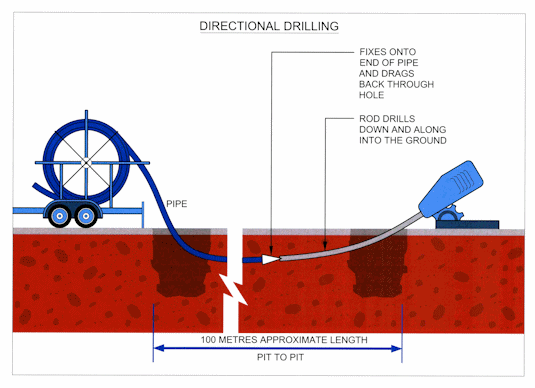
In Gosport it was necessary to provide a 300mm diameter main to serve a new development which meant crossing Forton Lake. The new main was installed beside the footbridge using the directional drilling technique thus avoiding large scale disruption to the creek and minimising the ecological impact.
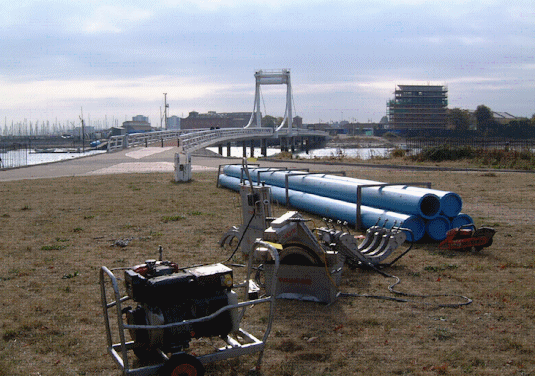
A pilot hole was drilled first. As the drilling rods were then withdrawn the hole was enlarged with the ‘reamer’ (rusty looking barrel in centre of picture) and the pipe pulled through behind.
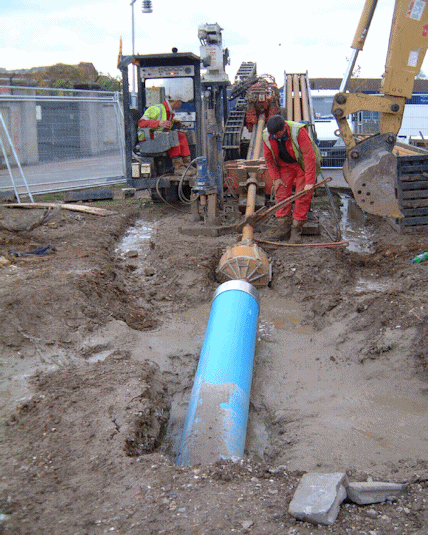
A small pit is excavated at each end of the pipe that is being replaced, and a small section of the old pipe is broken out. The slightly smaller plastic pipe is inserted into the old pipe and pushed along the section to be replaced. Although the new plastic pipes are smaller, the smoother surface ensures the amount of water carried through the pipe is not reduced by an unacceptable amount. The technique is not suitable for all pipe materials.
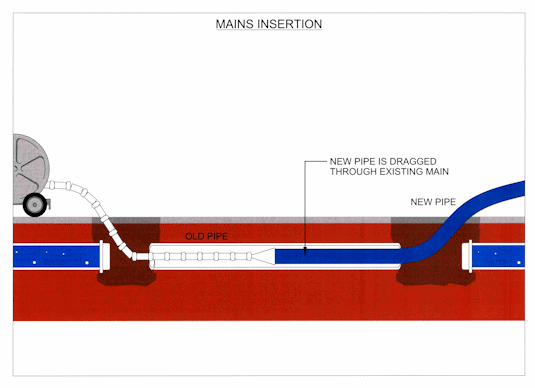
This technique was used in Queens Street, Portsmouth (above) in order to minimise traffic disruption, and again in Eastney Road, Southsea (below). The excavator is pushing / pulling the blue plastic pipe into the open end of the old cast iron main.
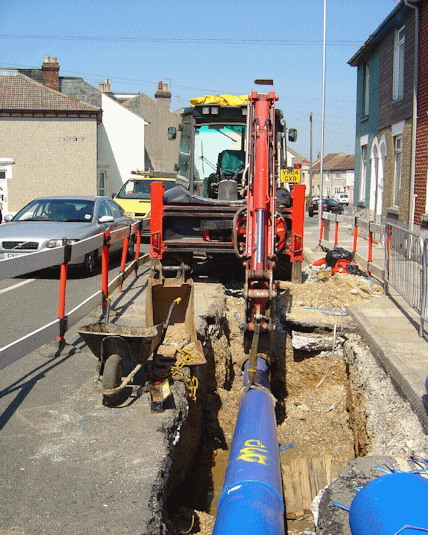
If a trenchless method is inappropriate, we revert to the more traditional open trench method of installation. A trench is excavated running parallel to the old water main and the new pipe is laid in this trench. The technique is suitable for all pipe materials, however, disruption to road users is greatest and costs of reinstatement can be high.
All techniques require an excavation at the point of connection of the customers service pipe and stop valve to enable the customers service pipe to be transferred to the new main.
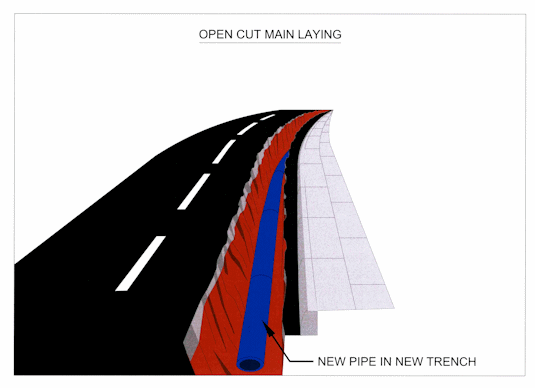
In the photo below an open trench water mains renewal is in progress in a residential area . The trench has been excavated and the new pipe is in the process of being installed.
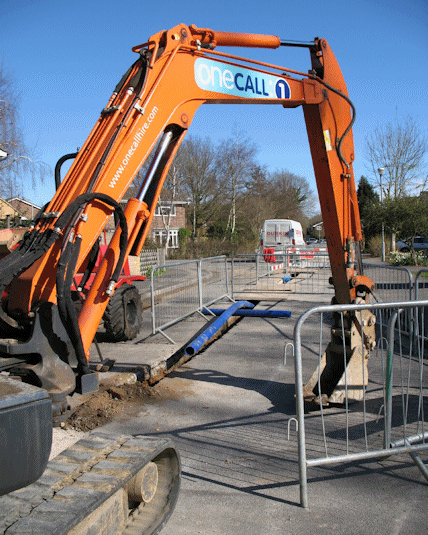
In the photo below an open trench water mains renewal is in progress in a rural area . The excavated trench awaits installation of the pipe. Once installed the trench is backfilled and the road / verge reinstated to match as nearly as practicable the original surface.

We usually replace our stopvalve (also known as a stopcock), the boundary box, and the communication pipe (i.e. the part of the service pipe outside your property boundary). A key to operate the stopvalve can be purchased at our Head Office in Havant.
Inside your property boundary you are responsible for the pipework. This part (see diagram) is known as the supply pipe.

Communication Pipe - Portsmouth Water Responsible
Supply Pipe - Customer Responsible (Please click here to view areas of responsibility)
An example of the service pipe to a property being replaced.

Loss of water supply
We will contact customers whose water supplies are likely to be interrupted. Generally these customers have properties adjacent (or nearby) to the road in which the water main is being replaced. Regrettably, there will be at least three occasions when it will be necessary to turn off the water supply:
- To enable the new main to be connected to the existing water mains network – this will result in a loss of supply for between 2 and 8 hours.
- To transfer your water service pipe from the old main to the new main – this element of work is generally carried out in less than 1 hour. The loss of supply will be about 15 minutes.
- To disconnect the old main from the water mains network - this will result in a loss of supply for between 2 and 8 hours.
Prior to these planned interruptions we will notify the customer in writing 48 hours in advance of the ‘turn off’. When the water service pipe is to be transferred our contractor will call at the customers’ premises shortly before the work is to be carried out.
When your water supply is turned off, please:
- do not use cold water taps
- do not use household appliances such as washing machines, and dishwashers, which rely on a constant supply of water
- do not use other devices running on mains water pressure
A correctly installed and maintained standard central heating system will operate safely during the period of interruption but combination boilers will not work and should not be used.
When your water supply is turned back on our contractor will call again. If you are not in and he suspects that a tap may be running or the supply pipe may have a leak, he is under instruction for safety reasons to turn off the ‘stopvalve’ controlling your supply. If you are unable to restore the supply yourself please contact us via Portsmouth Water 24 hours Operations Centre on 02392 477 999, who will arrange for the water to be restored.
The photo below shows an example of where your outside stop valve can be located.

Before using your tap water again, we recommend that you run the cold kitchen tap for a few minutes until the water runs clear. Do not use household appliances, especially the shower, dishwasher and washing machine, until the water runs clear.
If your water does not come back on, please firstly ask your neighbours whether their supply has been restored, and secondly check that your inside stop valve is fully open by turning it off and then on again.
The photo below shows an example of where your inside stop valve may be located.


Do not leave your kitchen tap open waiting for the supply to be restored, as this could cause flooding.
Access to Properties
Regrettably, as a customer whose property is adjacent to the water main it is inevitable that access to your property will be affected. It may be that it is not possible to park in the immediate vicinity during the working day, and, on occasions, overnight. Our contractor is under instruction to maintain access at all times when work is in progress immediately outside your home, however it may be necessary to temporarily block your entrance. In these circumstances the contractor will contact you beforehand in order that you may make suitable arrangements.
Disturbance
Construction work associated with laying water mains in the public highway will inevitably cause some inconvenience to our customers. We do have experience of this type of work and all of our staff will be working hard to minimise the impact of the work. If you have any specific concerns either now or during the construction work our site supervisory staff or office based staff will be pleased to assist you; please do not hesitate to contact us.
Traffic Management
The road works may affect residents’ journey time to and from home, whether they travel on foot or by car. Traffic management is key, and like other utility companies we have to agree beforehand with the local highway authority the duration of road occupation, the extent of signage, traffic light working, and diversionary routes. We appreciate that this may affect access to properties, car parking on the street, and journey times for motorists. We strive to complete our works in a way that minimises disruption to both our customers and other road users.
As identified previously it is necessary to pressure test and sterilise the new main following mainlaying as part of the commissioning process. During this period there is often little or no activity on site, a situation which some road users find frustrating.
If car parking is an issue we will place ‘No Waiting Cones’. This is to not only provide sufficient room for the mainlaying works to be undertaken, but also to minimise the risk of damage to cars which would otherwise be parked on the street.
Electrical Earthing
When the water mains are renewed the existing metal pipes will, in most cases, be replaced with plastic pipes. Very occasionally this affects the electrical earthing of properties; typically those properties not rewired since 1966. If you have any doubts about your electrical earth you must contact a qualified electrician. Portsmouth Water are not responsible for the provision of electrical earthing.
On occasions where mains renewals are proposed in several roads in close proximity, we may carry out what we refer to as a Blanket Mains Renewals Scheme. In these areas whilst the process of renewal is the same, the activities are more intense and cover a wider area.
A coordinated customer communication campaign is carried out for these schemes and discussions held with community and business groups and other key stakeholders to enable a detailed programme to be prepared with the objective of minimising the impact of our work on our customers and road users.